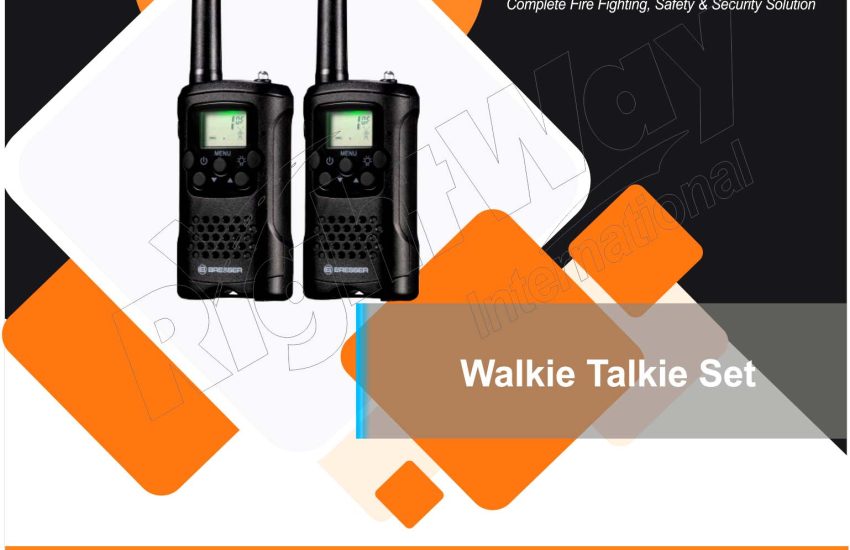Walkie Talkie Set are essential communication tools used across various sectors including security, outdoor activities, construction, and emergency services. They offer reliable and immediate communication without relying on cellular networks, making them invaluable in both routine and critical situations. This article explores the key features, applications, benefits, and best practices for using walkie talkie sets.
Features of Walkie Talkie Sets
- Frequency Range: Walkie talkies operate on different frequency bands such as UHF (Ultra High Frequency) and VHF (Very High Frequency). UHF radios are better for urban environments with obstacles, while VHF radios are ideal for open areas with longer range.
- Communication Range: The effective communication range of a walkie talkie can vary based on its power output, frequency, and environmental factors. Typical ranges can range from a few miles in urban areas to over 25 miles in open spaces.
- Battery Life: Battery life is a critical factor, especially for extended use. Walkie talkies come with rechargeable batteries or replaceable ones, with some models offering extended battery life for longer missions.
- Durability and Build: Walkie talkies are often designed to withstand harsh conditions. Look for features such as water resistance, shockproof construction, and rugged design for use in challenging environments.
- Channels and Privacy Codes: Walkie talkies usually operate on multiple channels to avoid interference. Privacy codes can be used to create private communication channels within the same frequency band, enhancing security.
- Additional Features: Modern walkie talkies may include features such as GPS tracking, emergency alerts, VOX (voice-activated transmission), and LCD screens for easier operation and monitoring.
Applications of Walkie Talkie Sets
- Security and Safety: Walkie talkies are widely used by security personnel to coordinate and communicate effectively across large areas, such as malls, events, and corporate buildings.
- Outdoor Activities: In recreational activities like hiking, camping, and skiing, walkie talkies are used for staying in touch with groups or companions in remote areas where cellular service may be unavailable.
- Construction and Industrial Sites: On construction sites, walkie talkies facilitate communication between workers, supervisors, and site managers, ensuring smooth operations and quick response to issues.
- Emergency Services: Emergency responders, such as police, fire fighters, and medical teams, use walkie talkies for reliable communication in critical situations where other communication methods may fail.
- Event Management: For managing large events like concerts or festivals, walkie talkies help coordinate staff, manage logistics, and address any issues that arise efficiently.
Benefits of Using Walkie Talkie Set
- Instant Communication: Walkie talkies provide immediate communication with a push-to-talk button, allowing for quick updates and coordination without delay.
- Reliability: Unlike cellular phones, walkie talkies do not rely on network coverage, making them reliable in areas with poor or no cellular reception.
- Cost-Effective: Walkie talkies do not incur ongoing costs like cellular plans or data charges, making them a cost-effective solution for communication.
- Durability: Designed for tough conditions, walkie talkies can endure physical stress, environmental factors, and rough handling, making them suitable for demanding environments.
- Ease of Use: Most walkie talkies are user-friendly with simple controls, making them accessible for users of all experience levels.
Best Practices for Using Walkie Talkie Set
- Understand the Range and Frequency: Familiarize yourself with the communication range and frequency settings of your walkie talkies. Ensure they are suitable for the environment where you will be using them.
- Regular Battery Maintenance: Keep batteries charged and perform regular maintenance checks. Carry spare batteries if extended use is expected.
- Use Headsets for Privacy: For discreet communication, use headsets with built-in microphones. This can prevent overhearing and improve clarity in noisy environments.
- Adjust Settings for Optimal Performance: Set the appropriate channels and privacy codes to minimize interference from other users. Adjust the volume and squelch settings for clear communication.
- Keep Walkie Talkies Clean and Maintained: Regularly clean the devices and check for any signs of damage. Ensure that all buttons, screens, and connectors are functioning properly.
- Follow Protocols for Effective Communication: Establish clear communication protocols with your team, such as using specific codes or signals for common messages. This helps in maintaining clarity and reducing confusion.
Conclusion
Walkie talkie sets are essential tools for effective and reliable communication in a variety of settings. By understanding their features, applications, and best practices, users can maximize their effectiveness and ensure seamless communication. Whether for security, outdoor adventures, construction, or emergency response, choosing the right walkie talkie and maintaining it properly can significantly enhance coordination and operational efficiency.


